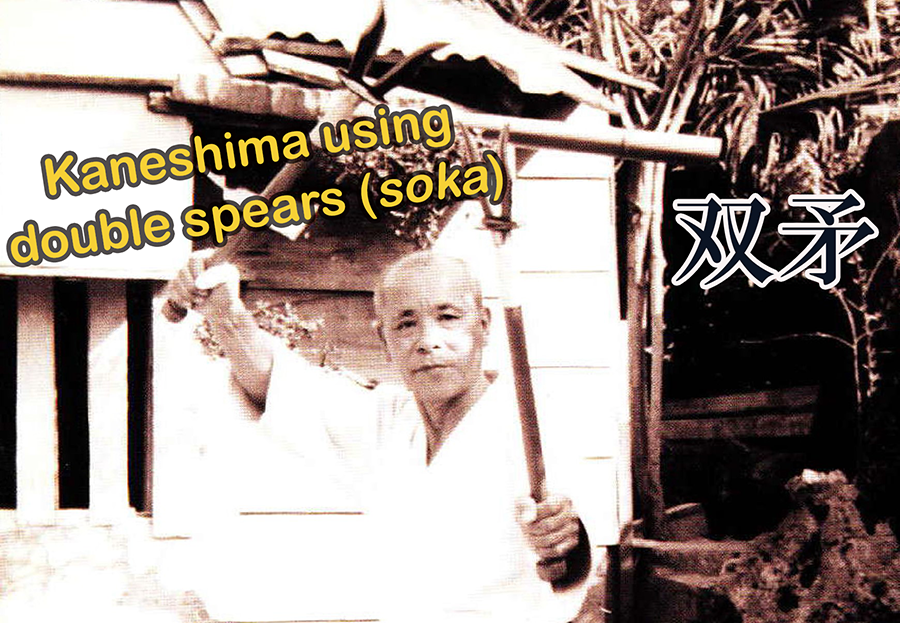In September 1969, Kaneshima Shinsuke together with Nagamine Shoshin apperad in an Okinawa Times article about the “model demonstrations” to be held at Okinawa Times Hall on September 25th, and in preparation of demonstrations at Nippon Budokan on October 10.
Elsewhere, Kaneshima’s martial curriculum vitae was published. It shows an intruiging collection of techniques and weapons over a long period of time.
When looking at the techniques, there are many original kata of karate and kobudo among it. Besides, there are also methods that are usually unheard of in karate of the time, or at least most other persons did not mention them. For instance, Kaneshima learned Ānankō from Kyan Chotoku in 1931, bojutsu from Oshiro Chojo (here written as Chodo). From Motobu Choki, who is usually believed to have “only” taught Naihanchi, Kaneshima learned three kata as well as Hindī (variations of application) and Ate-waza (blows to vital points of the human body). He also learned four kata from Choki’s older brother, Motobu Choyu, as well as Toite (joint locks and throwing techniques, also known as Tuite, Tuidi) and again Hindī (variations of application). Kaneshima actually started to learn karate after he apllied to become a student of Motobu Choyu, and was taught at the Motobu residence (Motobu Udun).
As regards Hindī, the word and meanig was not very well known even among Okinawan karateka. It is an example how things are forgotten, but something new is developed under a different name to fill the void. Yes, it means if they didn’t know Hindī, they didn’t learn it. What this means is as Nagamine Shoshin wrote:
About kumite
A long time ago kumite was referred to as “hente” (Oki.: hindī). The term “kumite” was probably first documented in written form in the textbook “Karate Kumite” by Hanashiro Chōmo Sensei, written in August 1905. Kumite is not something separated from kata, quite on the contrary: It means the “applied skills” (ōyō-te) transformed from the kata.
In short: Hindī was an original Okinawan word for kata bunkai, for ōyō, or for kata put to practice.
It is really extraordinary. Enjoy!
Kaneshima Shinsuke’s martial curriculum vitae
Motobu Chōyū
- January 1911 (age 15) to July 1914 (age 18)
- January 1915 (age 19) to March 1918 (age 22)
- Naihanchi, Passai, Chintō, Sōchin, Toite (throwing technique), Hindī (variations of application)
Tokuyama Chōgi
- April 1918 (age 22) to May 1919 (age 23) [Place: Taiwan]
- April 1928 (age 32) to November 1928 (age 32) [Place: Taiwan]
- Kobujutsu, Sai, Tonfā, Nunchaku, Kenpō, Ronshin, Rūshan
Chen Pantong
- December 1928 (age 32) to March 1929 (age 33) [Place: Taiwan]
- Chinese kenpō, Ronshin, Rūshan, Taijutsu, “hand techniques” (either hand throwing techniques or otherwise)
Motobu Chōki
- March 1920 (age 24) to November 1922 (age 26) [Place: Ōsaka]
- March 1932 (age 36) to June 1933 (age 37) [Place: Tōkyō]
- Naihanchi, Wanshū, Jitte, Hindī (variations of application), Ate-waza (blows to vital points of the human body)
Shiroma Shinpan
- November 1929 (age 33) to October 1934 (age 38) [Place: Shuri]
- Pinan Shodan to Godan, Kōsōkun Dai and Shō, Chintō, Chintē, Jion, Jitte, Jiin, Passai Dai and Shō, Gojūshiho, Seisan, Sanchin, Kumite techniques
Ōshiro Chōdo
- July 1930 (age 34) to September 1931 (age 35)
- Passai, Bōjutsu, Shūshi no Kon, Sakugawa no Kon
Kyan Chōtoku
- January 1931 (age 35) to June 1931 (age 35)
- Ānankō
© 2023, Andreas Quast. All rights reserved.

